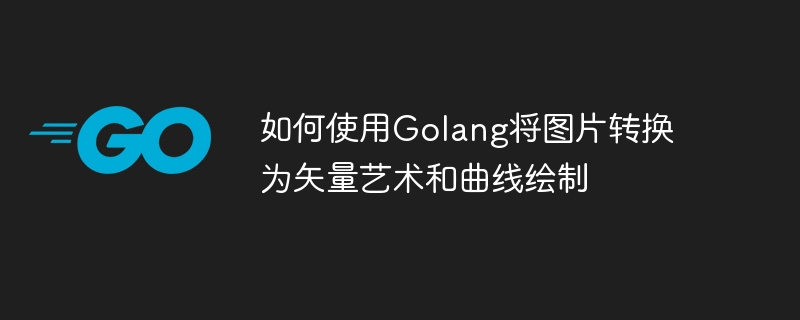Home >Backend Development >Golang >How to convert pictures to vector art and curve drawing using Golang
How to convert pictures to vector art and curve drawing using Golang
- WBOYWBOYWBOYWBOYWBOYWBOYWBOYWBOYWBOYWBOYWBOYWBOYWBOriginal
- 2023-08-19 19:49:521583browse

How to use Golang to convert pictures into vector art and curve drawing
Introduction:
With the development of digital art, people are increasingly fond of vector art and curve drawing to express your creativity. This article will introduce how to use the Golang programming language to convert pictures into vector art and curve drawing, providing readers with a simple and practical sample code.
1. Preparation:
First, we need to make sure that our Golang development environment has been installed and configured correctly. We also need to install a third-party library for processing images - Go Image Library (go Image Library), whose source code can be found on GitHub.
2. Import the necessary libraries:
Before we start writing code, we need to import some necessary libraries. First, we should import the Go image library for loading and processing images. In addition, we also need to use Golang's built-in graphics library and file operation library.
import (
"fmt"
"image"
_ "image/jpeg"
_ "image/png"
"os"
)3. Open and decode the image:
Now, we can write code to open and decode the image file. We need to open the image file using the Open function and decode it into a image.Image object using the Decode function.
func openImage(filePath string) (image.Image, error) {
file, err := os.Open(filePath)
if err != nil {
return nil, err
}
defer file.Close()
img, _, err := image.Decode(file)
if err != nil {
return nil, err
}
return img, nil
}4. Convert the image to vector art and curve drawing:
Now, we can start converting the image to vector art and curve drawing. We can create a curve by using pixel color values.
func convertToArt(img image.Image) {
bounds := img.Bounds()
for y := bounds.Min.Y; y < bounds.Max.Y; y++ {
for x := bounds.Min.X; x < bounds.Max.X; x++ {
color := img.At(x, y)
// 根据像素颜色值进行曲线绘制
// ...
}
}
}In the above code, we iterate through each pixel of the image and get the color value of each pixel using the img.At(x, y) method. Based on our previous needs, we can use this color value to draw the corresponding curve. Here, the code logic for drawing the curve will vary based on our specific needs.
5. Complete sample code:
The following is the entire sample code:
package main
import (
"fmt"
"image"
_ "image/jpeg"
_ "image/png"
"os"
)
func main() {
filePath := "image.jpg"
img, err := openImage(filePath)
if err != nil {
fmt.Println("无法打开图像文件:", filePath)
return
}
convertToArt(img)
}
func openImage(filePath string) (image.Image, error) {
file, err := os.Open(filePath)
if err != nil {
return nil, err
}
defer file.Close()
img, _, err := image.Decode(file)
if err != nil {
return nil, err
}
return img, nil
}
func convertToArt(img image.Image) {
bounds := img.Bounds()
for y := bounds.Min.Y; y < bounds.Max.Y; y++ {
for x := bounds.Min.X; x < bounds.Max.X; x++ {
color := img.At(x, y)
// 根据像素颜色值进行曲线绘制
// ...
}
}
}Please note that the above code is just an example, real vector art and curve drawing may require more complex algorithms and logic to generate more precise results.
Conclusion:
By using Golang programming language, we can easily convert images into vector art and curve drawing. By loading and decoding an image, then looping through each pixel and using its color value to curve, we can achieve very interesting and creative effects. Hopefully this article will help you further explore the creative process of image processing and artistic results.
The above is the detailed content of How to convert pictures to vector art and curve drawing using Golang. For more information, please follow other related articles on the PHP Chinese website!

